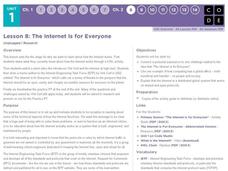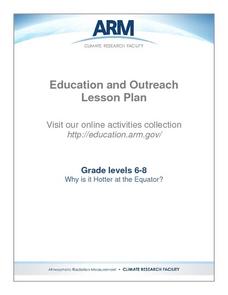Curated OER
The Best of the Solar System - Planetary Research
Students increase their ability to recognize the planets and their surface features. In this exploratory activity students focus on details by studying uncaptioned images.
Curated OER
Mother Earth - Father Sky
Third graders research and write about Cyrus Dillan. They explain one of Dillan's sculptures. Students locate six constellations and two planets. They research and write about the daily life of the Pawnee.
Curated OER
Let's Build a City In the Solar System
Sixth graders explore the solar system. Using the Internet, 6th graders gather information about planets in our solar system. Students participate in an activity to determine where they should build the first city in space. They create a...
Curated OER
Exploration
Students are engaged in a research project about the planet Saturn. The learners use research skills in books and on the internet to gather information for an imaginary trip to the planet. This lesson is highly engaging because of the...
Curated OER
Astronomy: A Star Party
Students explain the functions of a telescope. They name the parts of the telescope. After previously learning the planets and constellations, students identify and view them during a star party.
Curated OER
What are Brazil's Natural Resources?
High schoolers appreciate the gifts of natural resources on our planet and foster ways to protect them. They develop an awareness of the natural resources that are found in Brazil and use the Internet to research Brazil's resources.
Curated OER
Pede Patterns
Students generate number patterns for certain 'insects' from the mythical planet of Elsinore. Each 'Pede' is made up of square parts and has a number of feet. The patterns all link the number of feet and the number of squares. The...
Curated OER
Scale from the Solar System to a Monster Bee
Sixth graders are introduced to the concept of scale. As a class, they create a model of the solar system taking into account the scale between the planets and the Sun. To end the lesson, they examine "Dina the Monster Bee" and discover...
Curated OER
Human Factors
Students design a space settlement for colonizing a planet in our solar system. In small groups, they play a space colony game and read an article about human needs in space to prepare for the design stage. They discuss their design...
Curated OER
Introduce /ol/
Students pronounce out the /ol/ sound. In this lesson planet lesson, students search words with the /ol/ sound. Students say the words that contain /ol/ or remain quiet if they don't.
University of Colorado
Great Red Spot Pinwheel
The great red spot on Jupiter is 12,400 miles long and 7,500 miles wide. In this sixth part of a 22-part series, individuals model the rotation of the Great Red Spot on Jupiter. To round out the activity, they discuss their findings as a...
University of Colorado
The Jovian System: A Scale Model
Jupiter has 67 moons! As the seventh in a series of 22, the exercise shows learners the size and scale of Jupiter and its Galilean moons through a model. They then arrange the model to show how probes orbited and gathered data.
University of Colorado
The Moons of Jupiter
Middle schoolers analyze given data on density and diameter of objects in space by graphing the data and then discussing their findings. This ninth installment of a 22-part series emphasizes the Galilean moons as compared to other objects.
University of Colorado
Are All Asteroids' Surfaces the Same Age?
There are more than 600,000 asteroids in our solar system. Pupils analyze images of two asteroids in order to determine if they are the same age. They count craters for each asteroid and compare numbers.
Code.org
The Internet Is for Everyone
What is this thing called the Internet? A KWL activity elicits what the class knows about how the Internet works. Then pupils read a copy of a memo about the need to keep the Internet open and accessible by everyone.
University of Connecticut
Building Your Own Biosphere
On September 26, 1991, four women and four men entered the scientific experiment, Biosphere 2; the doors were sealed for two years in order to study the interactions of a biosphere. In the activity, scholars explore biospheres by...
Curated OER
Why Is It Hotter At the Equator?
Students investigate the different heating effects of sunlight. They conduct an experiment that demonstrates the way sunlight strikes the equator, the poles and other parts of the globe.
Curated OER
Titan and the Other Moons of Saturn
Students identify and describe the moons of Saturn. They sort the moons by their characteristics. They write a paragraph describing the moons to end the instructional activity.
Curated OER
All About Titan and the Huygens Probe
Students examine the characterisitics of Saturn's largest moon, Titan. They discuss what they think is on Titan and what the Huygens probe can tell them about the moon. They write a summary about the information they gathered during...
Curated OER
The Potential Consequences of Climate Variability and Change
Students analyze the impact of climate variability and change utilizing a broad span of topics over a wide range of grade levels. This three lesson unit is easily adapted for the various instructional levels listed.
Curated OER
Potential Consequences of Climate Variability and Change
Students examine the potential impact of climate change to agriculture, coastal areas, forests, water, and human health. They hypothesize what might happen to a sugar maple forest and hold a debate about global warming.
Curated OER
Measuring Where We Sit In The Universe
Students investigate scientific measurement. They use a variety of scales to do the job and communicate the results correctly. The teacher uses socratic questioning throughout the lesson checking for comprehension. Students measure some...
Curated OER
Weather / Seasons
Third graders hear and use the terms: el verano, la primavera, el invierno y el oto¿¿o. They review particular months in Spanish. Students explore the difference in connections between months and seasons in northern and southern...
Curated OER
Suited for Space
A fantastic lesson on survival in outer space should excite your learners! Pupils explore the challenges that living, working, and surviving in space elicit. They focus on the spacesuit itself; how it protects astronauts, and enables...

























